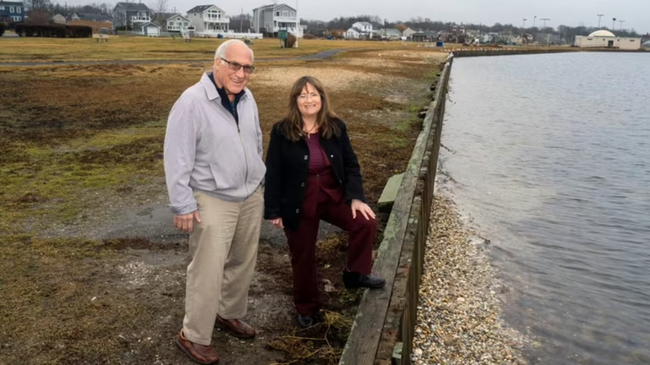
Patchogue Mayor Paul Pontieri Jr., and Marian H. Russo, executive director of the village's Community Development Agency, stand by wooden bulkheads at Shorefront Park in Patchogue on Thursday ahead of the start of a shoreline restoration program to combat flooding. Credit: Randee Daddona
— By Carl MacGowan, Newsday
Patchogue, NY, January 9, 2023 - The aging wooden bulkheads at Patchogue’s Shorefront Park — which regularly turns into more of a shorefront lake — will be swapped out in favor of stones and a marsh in an innovative effort to stem flooding.
The approach is considered a radical departure for Long Island, where waterfront communities have for a century or more depended on wooden slabs to protect marinas and coastlines from storm surges, officials said.
Climate change and rising sea levels required a change in thinking, Patchogue officials told Newsday.
“It’s considered cutting-edge for our region,” Patchogue Community Development Agency executive director Marian H. Russo said. “This is going to be a model for other areas to see how this works.”
Patchogue is planning a Jan. 24 groundbreaking for the $3,741,980 project, which will include redesigning other aspects of the park, such as boardwalks and benches. Construction should be completed by Memorial Day, officials said.
The plan, known as a "living shoreline," calls for laying rocks along an 800-foot stretch from Mascot Dock east toward Bayview Road. The rocks are expected to act as a porous barrier that should absorb and divert stormwater.
Little Creek, which cuts through the park, will be dredged and widened during a later phase of the project, officials said.
The project got a boost on Dec. 29 when Gov. Kathy Hochul announced Patchogue won a $3 million grant to fund most of the work. Combined with other state and Suffolk County grants, and funds from an anonymous donor, the project is fully funded, Russo said.
Patchogue officials said numerous storms have swept waves from Patchogue Bay into the park, where water collects in pools behind the bulkheads. A fierce Dec. 23 storm turned the park into what looked like a skating rink, they said.
“We had water all the way up to Harrison Street," Mayor Paul Pontieri told Newsday of an area three blocks from the park. "Eight to 10 inches of water that froze overnight. … That Christmas Eve day, we were down there — six inches of ice.”
The park includes a children's playground, a bandshell, a field for baseball and softball, basketball courts and restrooms.
Placing stones along coastlines has proved successful in other parts of New York, such as the Hudson Valley, but Patchogue will be the first such attempt on Long Island, said Kathleen M. Fallon, coastal processes and hazards specialist in the Stony Brook office of nonprofit New York Sea Grant.
Using rocks is a “hybrid technique” that adapts a natural approach to water filtration using modern engineering techniques, she said.
“I would say it’s innovative for New York state," added Fallon, an unofficial adviser on the Patchogue project. "Living shorelines have been utilized in other areas of the country, particularly Jersey, Connecticut, the Chesapeake Bay, which is a … coastal environment similar to Long Island.”
Russo said while storm surges are inevitable, the improved coastline should provide better protection for the popular park.
“It can’t be any worse than we have right now,” the mayor said.
Sidebar: Keys to building a "living shoreline" to protect Shorefront Park in Patchogue from flooding (Source: Village of Patchogue)
• Remove about 800 feet of wood bulkheading
• Replace it with stones along the shoreline
• Redesign boardwalks and benches
• Develop a marsh with native plants to absorb stormwater
• Dredge Little Creek, which will be widened during a later project phase
More Info: New York Sea Grant
New York Sea Grant (NYSG), a cooperative program of Cornell University
and the State University of New York (SUNY), is one of 34 university-based
programs under the National Oceanic and Atmospheric Administration’s
National Sea Grant College Program.
Since 1971, NYSG has represented a statewide network of integrated
research, education and extension services promoting coastal community
economic vitality, environmental sustainability and citizen awareness
and understanding about the State’s marine and Great Lakes resources.
Through NYSG’s efforts, the combined talents of university scientists
and extension specialists help develop and transfer science-based
information to many coastal user groups—businesses and industries,
federal, state and local government decision-makers and agency managers,
educators, the media and the interested public.
The program maintains Great Lakes offices at Cornell University, SUNY
Buffalo, SUNY Oswego and the Wayne County Cooperative Extension office
in Newark. In the State's marine waters, NYSG has offices at Stony Brook
University in Long Island, Brooklyn College and Cornell Cooperative
Extension in NYC and Kingston in the Hudson Valley.
For updates on Sea Grant activities: www.nyseagrant.org has RSS, Facebook, Twitter, Instagram, and YouTube links. NYSG offers a free e-list sign up via www.nyseagrant.org/nycoastlines for its flagship publication, NY Coastlines/Currents, which is published quarterly.